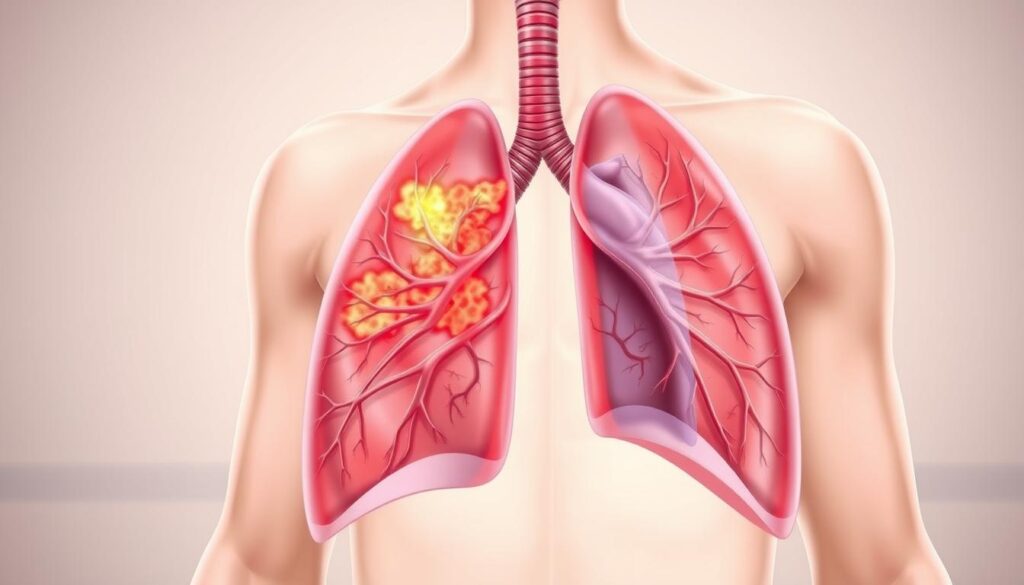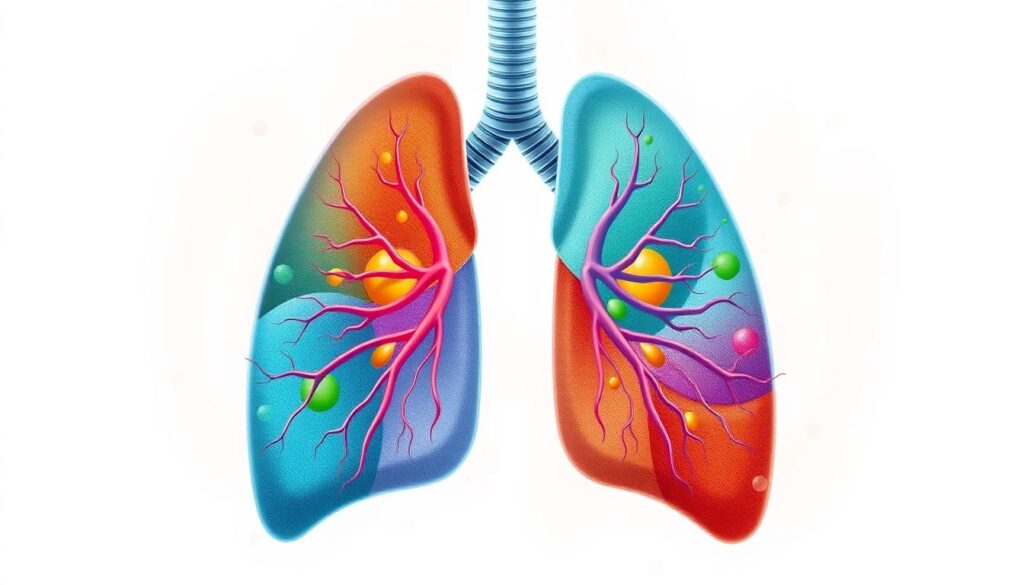Did you know bronchiectasis, a chronic lung condition, affects over 340,000 people in the United States? This disease can really hurt your quality of life. It leads to frequent respiratory infections and damage to your lungs. In this guide, we’ll look at the causes, symptoms, and treatments for bronchiectasis. This will help you manage your respiratory health better.

Key Takeaways
- Bronchiectasis is a chronic lung condition characterized by permanently widened airways.
- Common causes include respiratory infections, genetic disorders, and underlying lung conditions.
- Symptoms range from persistent cough and excessive mucus production to shortness of breath and recurring infections.
- Prompt diagnosis and a combination of medical treatments, lifestyle modifications, and pulmonary rehabilitation can help manage the condition.
- Early detection and proactive management are crucial for maintaining respiratory health and improving quality of life.
Understanding Bronchiectasis: A Chronic Lung Condition
Bronchiectasis is a long-term lung disease. It causes the airways to permanently widen. This happens because of repeated infections or blockages, leading to trouble breathing and mucus buildup. It’s important to understand how bronchiectasis affects the airways and daily life to manage it well.
How Bronchiectasis Affects the Airways
In people with bronchiectasis, the airways get damaged. They can’t clear mucus well anymore. This causes mucus to build up, making breathing harder and raising the chance of infections.
The mucus buildup and changed airway shape also affect how air and gas move in the lungs. This can make breathing and gas exchange harder.
The Impact on Daily Life
Bronchiectasis can really affect a person’s life. The chronic cough, lots of mucus, and frequent infections can make everyday tasks hard. It can also make it hard to exercise and feel well overall.
Patients might feel tired, have trouble breathing, and struggle with simple tasks. This can lower their quality of life.
To improve health and daily life, managing bronchiectasis is key. This includes dealing with airway blockages and improving mucus removal. Regular check-ups, the right treatment, and making lifestyle changes can help lessen the disease’s impact.
“Bronchiectasis can have a significant impact on a patient’s quality of life, but with proper management, individuals can find ways to manage their symptoms and improve their daily functioning.”
Common Causes and Risk Factors of Bronchiectasis
Bronchiectasis is a complex condition with many potential causes. Knowing what causes it is key to managing and preventing it. Let’s look at some common causes and risk factors for this chronic lung disorder.
Cystic fibrosis is a leading cause of bronchiectasis. It’s a genetic disorder that affects the lungs and digestive system. People with cystic fibrosis often get recurring lung infections. These infections can damage and scar the airways, leading to bronchiectasis.
Non-tuberculous mycobacteria (NTM) infections are another significant cause. These bacteria can infect the lungs, especially in people with weak immune systems or lung problems. NTM infections can cause long-term inflammation and damage, leading to bronchiectasis.
- Repeated respiratory infections, like pneumonia or flu, can also raise the risk of bronchiectasis by damaging airways over time.
- Autoimmune disorders, such as rheumatoid arthritis or Sjögren’s syndrome, can make people more susceptible to bronchiectasis.
- Exposure to harmful substances, like air pollution or cigarette smoke, can also contribute to this condition.
While these are common causes, the exact cause of bronchiectasis is not always known. Genetic and environmental factors, as well as other medical conditions, can increase a person’s risk of getting this chronic lung disease.
“Understanding the root causes of bronchiectasis is essential for providing effective and personalized treatment strategies.”

Healthcare professionals can create personalized treatment plans by recognizing the many causes and risk factors. This approach helps improve outcomes and quality of life for those with bronchiectasis.
Recognizing the Signs and Symptoms
Bronchiectasis is a chronic lung disease with varied symptoms. Spotting these signs early is key for quick diagnosis and treatment.
Early Warning Signs
The first signs of bronchiectasis can be mild and confused with other lung issues. Look out for:
- A persistent cough that brings up a lot of mucus or phlegm
- Frequent lung infections like pneumonia or bronchitis
- Wheezing or whistling sounds when you breathe
- Feeling short of breath, especially when you’re active
Advanced Symptoms
As bronchiectasis gets worse, symptoms can become more serious. These include:
- A long-lasting cough that produces a lot of mucus or phlegm
- Recurring chest infections that might need hospital care
- Feeling very tired and not being able to exercise as much
- Pain or discomfort in the chest
- Unintentional weight loss
When to Seek Medical Attention
If you notice any of these symptoms, especially if they get worse, see a doctor. Early treatment can slow the disease’s progress and improve your life.
| Symptom | Description | Potential Causes |
|---|---|---|
| Persistent cough | Chronic, productive cough that does not go away | Respiratory infections, chronic lung disease, bronchiectasis |
| Frequent respiratory infections | Repeated episodes of pneumonia, bronchitis, or other respiratory illnesses | Weakened immune system, chronic lung disease, bronchiectasis |
| Shortness of breath | Difficulty breathing, especially during physical activity | Chronic lung disease, cardiovascular issues, bronchiectasis |
“Early recognition and management of bronchiectasis symptoms are crucial for improving patient outcomes and quality of life.”
Diagnostic Process and Testing Methods
Diagnosing bronchiectasis requires a detailed evaluation. It checks the airway obstruction and looks for respiratory infections. The process includes imaging studies, pulmonary function tests, and sputum analysis.
A high-resolution computed tomography (HRCT) scan of the chest is key. It shows detailed lung images. This helps doctors see airway damage from bronchiectasis.
Pulmonary function tests, like spirometry, also play a role. They measure lung function and air flow. These tests help figure out how severe the condition is and guide treatment.
Sputum analysis is crucial too. It examines mucus from the lungs for respiratory infections. These infections can worsen bronchiectasis.
| Diagnostic Test | Purpose |
|---|---|
| High-Resolution Computed Tomography (HRCT) Scan | Visualize structural changes and damage to the airways |
| Pulmonary Function Tests (Spirometry) | Evaluate lung function and air flow |
| Sputum Analysis | Identify underlying respiratory infections |
Using these tests, doctors can accurately diagnose bronchiectasis. They can then create a treatment plan. This plan aims to manage the condition and address any underlying issues.
Medical Treatment Options and Management Strategies
Dealing with bronchiectasis needs a detailed plan, made just for each patient. This plan includes antibiotics, ways to clear mucus, and bronchodilator medicines. These steps help manage the condition well.
Antibiotic Therapy Approaches
Antibiotics are key in fighting off infections that keep coming back. Doctors pick the right antibiotics for each patient. They do this based on the bacteria causing the infection. This helps stop the infection and protects the lungs.
Mucus Clearance Techniques
Too much mucus and trouble getting it out are big problems in bronchiectasis. There are many ways to help clear mucus, like:
- Airway clearance therapies, including chest physiotherapy and special devices
- Drinking lots of water, like with nebulized saline, to make mucus easier to move
- Using postural drainage and other ways to help mucus move out
These methods help patients clear their lungs better. This reduces infections and improves breathing.
Bronchodilator Medications
Bronchodilators help open up airways. They make breathing easier, help with exercise, and improve lung function. Doctors choose the right bronchodilators for each patient’s needs.
Fixing bronchiectasis needs a mix of treatments. It’s about treating the cause, managing symptoms, and helping patients take care of themselves. With the right plan, patients can live better with this chronic lung disease.

Living with Bronchiectasis: Lifestyle Modifications
Living with chronic lung disease like bronchiectasis means making big lifestyle changes. These changes help manage respiratory infections and improve life quality.
Eating right is key to lung health. People with bronchiectasis should eat lots of fruits, veggies, and lean meats. Drinking lots of water also helps clear mucus and makes breathing easier.
It’s important to avoid things that can harm your lungs. Stay away from smoke, dust, and fumes. Also, washing your hands often can stop the spread of infections.
Don’t forget about the emotional side of living with a chronic illness. Getting support from doctors, joining groups, and finding ways to relax can help a lot.
| Lifestyle Modification | Benefits |
|---|---|
| Balanced, Nutrient-Rich Diet | Supports lung health and immune function |
| Adequate Hydration | Thins mucus secretions for easier clearance |
| Avoidance of Irritants | Reduces risk of exacerbations and further lung damage |
| Emotional Support and Stress Management | Improves overall well-being and coping |
By making these lifestyle changes, people with bronchiectasis can manage their condition better. It makes everyday life more enjoyable.
“The key to living well with bronchiectasis is to actively participate in your own care and make adjustments that support your lung health and overall well-being.”
Pulmonary Rehabilitation and Exercise Programs
For those with bronchiectasis, pulmonary rehabilitation and exercise programs are key. These programs help improve lung function, muscle strength, and overall well-being. They include breathing exercises and physical activities to manage the condition and improve daily life.
Breathing Exercises
Breathing exercises are crucial in pulmonary rehabilitation for bronchiectasis patients. Led by respiratory therapists or physiotherapists, these exercises boost lung capacity and clear mucus. They also help develop better breathing habits.
- Diaphragmatic breathing, which enhances the use of the diaphragm to maximize air intake
- Pursed-lip breathing, which helps regulate airflow and alleviate shortness of breath
- Chest physiotherapy techniques, such as postural drainage and chest percussion, to loosen and expel mucus
Physical Activity Guidelines
Pulmonary rehabilitation also includes physical activities tailored to each person’s abilities and goals. These activities may include:
- Low-impact aerobic exercises, such as walking, cycling, or using an elliptical machine, to improve cardiovascular fitness
- Strength training exercises to build muscle endurance and overall physical function
- Flexibility and stretching routines to maintain joint mobility and range of motion
The success of pulmonary rehabilitation depends on a personalized approach. Healthcare professionals tailor the program to each bronchiectasis patient’s needs. By participating in these programs, individuals can manage their condition and improve their quality of life.
Prevention Strategies and Long-term Outlook
Managing bronchiectasis means taking steps to prevent complications. By using prevention strategies, people with chronic lung disease can slow the disease’s progress. This reduces the chance of getting respiratory infections.
Getting regular vaccinations is a key strategy. People with bronchiectasis should get the flu and pneumococcal vaccines. These vaccines protect against respiratory infections. Also, good hygiene habits like washing hands often and avoiding sick people help prevent infections.
Living a healthy lifestyle is also important. Quitting smoking and doing regular physical activity can improve lung function. Eating a diet rich in nutrients boosts the body’s defenses and helps respiratory health.
| Prevention Strategies | Potential Benefits |
|---|---|
| Regular vaccination | Reduces risk of respiratory infections |
| Practicing good hygiene | Minimizes exposure to respiratory pathogens |
| Quitting smoking | Improves lung function and overall health |
| Engaging in regular physical activity | Enhances respiratory muscle strength and endurance |
| Maintaining a balanced, nutrient-rich diet | Supports the body’s immune system and respiratory health |
Even though bronchiectasis is a chronic lung disease without a cure, the outlook is positive with proper care. By following prevention strategies and making lifestyle changes, many people with bronchiectasis can live better lives. They can have fewer respiratory infections and enjoy a better quality of life.
“Proactive management and a commitment to a healthy lifestyle are key to navigating the long-term challenges of bronchiectasis.”
Conclusion
In this guide, we’ve looked into bronchiectasis, a chronic lung condition. It can really affect someone’s life quality. We’ve covered everything from what causes it to how to spot symptoms early.
Getting diagnosed early and managing it well is key. Working with doctors, people can create treatment plans. These plans include medicines and ways to clear mucus, aiming to improve lung health.
Medical care is just part of the solution. Making lifestyle changes, like doing breathing exercises and staying active, also helps. These steps help manage bronchiectasis and improve health. By taking these steps, those with bronchiectasis can manage their chronic lung disease better.
FAQ
Q: What is bronchiectasis?
A: Bronchiectasis is a long-term lung condition. It makes airways permanently wider. This is often due to repeated infections or other health issues.
This condition causes airway blockage, mucus buildup, and makes infections more likely.
Q: What are the common causes of bronchiectasis?
A: Bronchiectasis can be caused by genetics, like cystic fibrosis. It can also come from repeated infections or damage to airways.
Autoimmune disorders or toxic fume exposure can also play a role. Non-tuberculous mycobacteria infections are another factor.
Q: What are the symptoms of bronchiectasis?
A: Early signs include a chronic cough and more mucus. Recurrent infections are also common.
As it gets worse, symptoms like shortness of breath and wheezing may appear. Chest pain and coughing up blood can also happen. It’s important to see a doctor if these symptoms don’t go away.
Q: How is bronchiectasis diagnosed?
A: Doctors use imaging tests like high-resolution CT scans. They also do pulmonary function tests to check lung health.
Sputum analysis helps find infections or bacteria. These tests help confirm the diagnosis.
Q: What are the treatment options for bronchiectasis?
A: Treatment focuses on managing infections with antibiotics. Techniques to clear mucus and bronchodilators to improve breathing are used.
Pulmonary rehabilitation programs are also helpful. They include breathing exercises and physical activity.
Q: How can lifestyle changes help manage bronchiectasis?
A: Eating right and avoiding harmful substances like cigarette smoke is key. Coping with the emotional side of the condition is also important.
Regular doctor visits and ongoing care are essential for managing symptoms and improving life quality.
Q: What is the long-term outlook for individuals with bronchiectasis?
A: The outlook depends on the cause, severity, and treatment. With good care, many can live well and slow disease progression.
But, serious complications like respiratory failure or heart issues can occur in severe cases.
